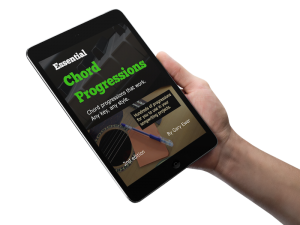A good chord progression has a sense of direction. It doesn’t just wander about, one nice chord following another nice one. Once a progression starts, it’s usually the case that it targets a particular chord, making that one chord more “important”, so to speak, than the others.
You see this targeting of that one important chord most easily in very basic progressions, like the I-IV-V-I progression:
C F G7 C
Once we’ve played the C and F chords, we get a sense of direction. Then when we add the G7 chord, we put it all together and make the assumption that we’re going to end on a C chord. That C chord is the tonic chord, the one that represents the key of the progression.
 “The Essential Secrets of Songwriting” eBook bundle includes “Writing a Song From a Chord Progression”. Discover the secrets to writing songs that start with getting a chord progression working.
“The Essential Secrets of Songwriting” eBook bundle includes “Writing a Song From a Chord Progression”. Discover the secrets to writing songs that start with getting a chord progression working.
button-red text=”Buy the Bundle ($37) or Read More” title=”The Essential Secrets of Songwriting online store” url=”https://www.secretsofsongwriting.com/prepurchase2.html”]
The Sense of Direction in a Chord Progression
Even non-musicians can hear that sense of direction that’s inherent in basic chord progressions. Mostly, it’s a cultural response. When you live in a culture where the music is based around these simple chord structures, you learn to expect what happens next.
Sometimes we get something different from what we expect, but that’s often nice too. For example, we might take that progression and put a surprise ending on it: moving, say, to Am instead of ending on C:
C F G7 Am
But even though we might throw surprises into a progression, there is still a strong sense of direction. Throwing chords around haphazardly doesn’t give us much musical satisfaction:
D Eb B F Dbm
So if progressions work best when we give them that all-important sense of direction, how do we do that?
Working From Simple to Complex
Mostly, we’re safe if we let our ear guide us. We can tell when things are working, and when things sound confusing. If you like starting the songwriting process by working out a usable chord progression first, it might be best to start by choosing a key.
Why choose a key first? Because once you know the key, you can create simple progressions that work. From there, you can take those simple progressions and make them more creative. But the best creative progressions start with simplicity at their core.
You might find it easiest to work in the key of C major or A minor, because those keys have no sharps or flats in their key signatures. If you’re a keyboardist, most of the chords will use the white keys. From there, you can transpose what you come up with to any key you want.
Choosing C major will give us seven chords right away that naturally occur in that key:
C Dm Em F G Am Bdim
If you like improvising your progressions, you’ll come up with some great progressions simply by limiting yourself to those seven chords. (And in fact, you can leave out Bdim for now, as that chord often needs to be used carefully.)
Your ear will tell you if you like what you’re coming up with. Here are some that work well:
- C F G C
- C Dm Am F G C
- C Am F G C
- C Em Am Em F G Am
- F C Dm G C
- Am G C Em F G C
You may think that these progressions are overly simple, but you should know that most songs in the pop genres (pop, rock, country, metal, etc.) don’t venture much beyond these.
But if you like chord progressions that are a little more complex, simply take one of these and start adding more creative choices to what’s already there. By working that way, you can keep your ear on how the progression sounds and decide if you like what you’re hearing.
For example, let’s take the 4th progression above and start making some modifications. For each modification, I’ve linked to an article that will tell you more about how to create those specific kinds of chords:
- A simple progression: C Em Am Em F G Am
- Add a modal mixture chord: C Em Am Em F Fm G Am
- Add a Flat-VII chord: C Em Am Em F Bb F Fm G Am
- Add a secondary dominant chord: C E Am Em F Bb F Fm G Am
- Add an inverted chord: C E Am Em F Bb F Fm G E/G# Am
In the samples above, I’ve kept adding to the basic progression, but you have so many options. You can then take any of the longer ones and see what happens when you try to remove some of the existing chords: C Am Bb Am; or C Em F Fm Am; etc.
In everything you do, keep asking yourself, “Do I like this?” Good music is good because it sounds good. But progressions that sound good usually have a strong sense of predictability at their core.
By taking simple progressions that work, then adding interesting moments to those progressions, you increase the likelihood that you’ll end up with a more complex progression that still works.
 Written by Gary Ewer. Follow Gary on Twitter.
Written by Gary Ewer. Follow Gary on Twitter.
 Looking for lists of progressions you can use in your own songs? “The Essential Secrets of Songwriting” eBook Bundle has 2 main collections, plus eBooks on how to harmonize your own melodies, and more.
Looking for lists of progressions you can use in your own songs? “The Essential Secrets of Songwriting” eBook Bundle has 2 main collections, plus eBooks on how to harmonize your own melodies, and more.










